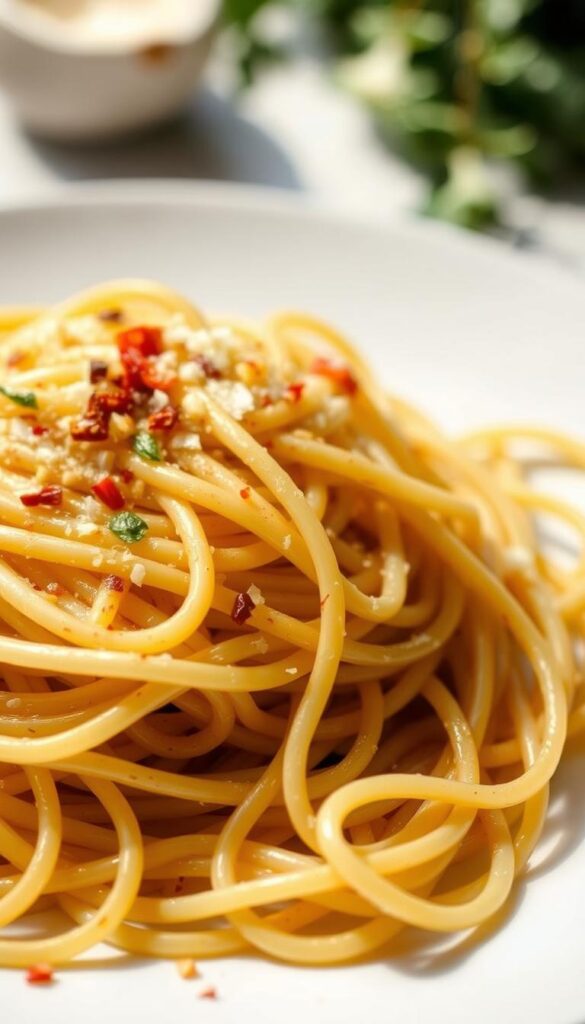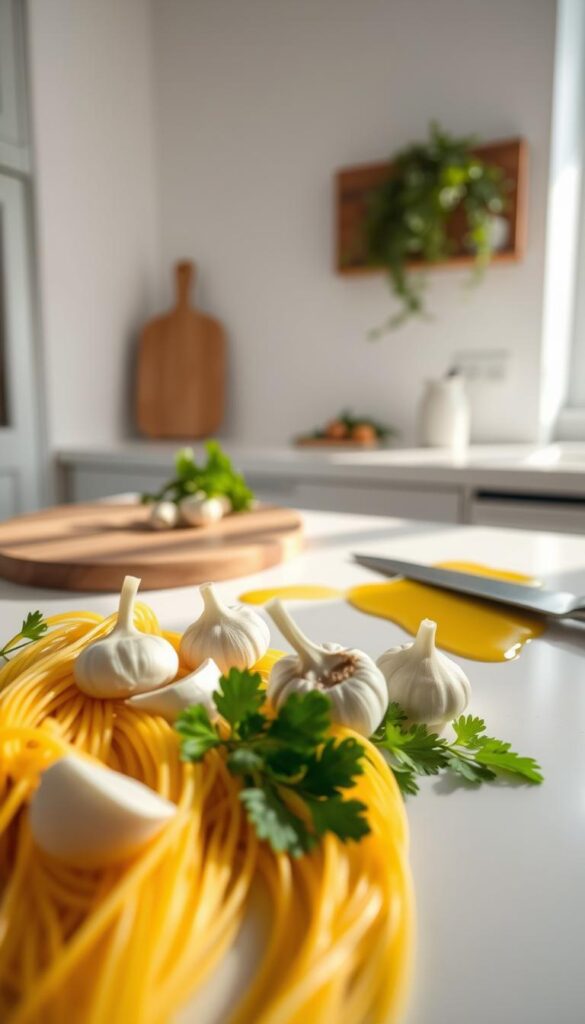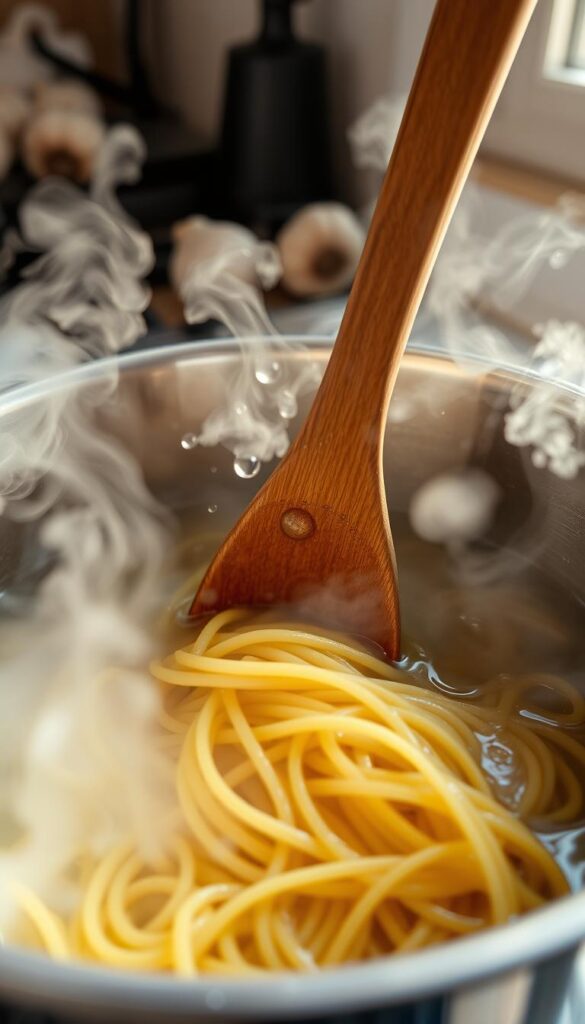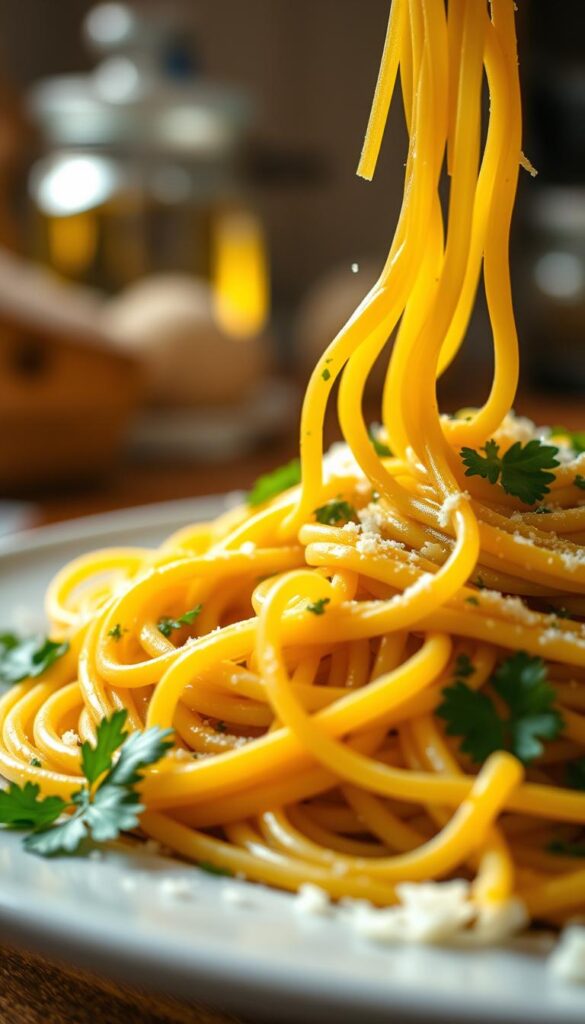You don’t need to be an expert chef to create an authentic Italian dish. Spaghetti aglio e olio, a classic from Naples, proves that with just a few quality ingredients, you can achieve incredible flavor.
This beloved pasta dish requires only four main ingredients: spaghetti, garlic, olive oil, and red pepper flakes. It’s a testament to Italian cooking’s philosophy of simplicity.
Ready in just 20 minutes, it’s perfect for a quick weeknight dinner. The key to elevating this dish lies in the techniques used to prepare its simple ingredients.
Key Takeaways
- Spaghetti aglio e olio is a simple yet flavorful Italian pasta dish.
- It requires only four main ingredients.
- The dish is ready in just 20 minutes.
- Techniques matter in elevating this simple dish.
- It’s a staple in Italian homes and restaurants.
The Classic Italian Pasta Dish
Spaghetti aglio e olio, a dish that embodies the simplicity and elegance of Italian cuisine, has been a staple in Italian households for generations. This classic pasta dish is not only easy to prepare but also requires minimal ingredients, making it a favorite among home cooks.
What is Spaghetti Aglio e Olio?
Spaghetti aglio e olio, which translates to spaghetti with garlic and oil, is a traditional Italian pasta dish originating from Naples. The simplicity of this dish lies in its few, high-quality ingredients: spaghetti, garlic, olive oil, and sometimes red pepper flakes for added heat. It’s a quintessential representation of Italian cooking, where a few ingredients come together to create something truly flavorful.

History and Cultural Significance
The origins of spaghetti aglio e olio can be traced back to Naples, Italy, where it was known as “vermicelli alla Borbonica,” named after the Bourbon dynasty that ruled Naples. Emerging from the cucina povera tradition, this dish showcases how simple, affordable ingredients can be transformed into a satisfying meal. The use of pantry staples like pasta, olive oil, and garlic made it a practical choice for many. Today, spaghetti aglio e olio is beloved across all social classes in Italy and has become an ambassador of Italian cuisine worldwide.
| Dish Characteristics | Description |
|---|---|
| Origin | Naples, Italy |
| Main Ingredients | Spaghetti, Garlic, Olive Oil |
| Cultural Significance | Represents Italian cooking philosophy of simplicity |
Essential Ingredients for Authentic Spaghetti Aglio e Olio
Understanding the key ingredients is vital to preparing a delicious Spaghetti Aglio e Olio. The authenticity of this Italian dish hinges on the quality and simplicity of its components.
The Four Key Components
The foundation of Spaghetti Aglio e Olio consists of four essential ingredients. Let’s explore each one:
Choosing the Right Pasta
Spaghetti is the traditional choice for this dish. Opt for high-quality, durum wheat semolina spaghetti for the best results.
Quality Olive Oil Matters
Extra virgin olive oil is crucial for its rich flavor and aroma. It serves as the base of the sauce, so its quality directly impacts the dish.
Garlic Preparation Techniques
Garlic is a fundamental flavor component. You can slice or mince it, depending on your preference, but be sure to cook it properly to avoid bitterness.
Red Pepper Flakes vs. Fresh Chili
Red pepper flakes are commonly used to add heat. However, you can also use fresh chili peppers for a different flavor profile.
| Ingredient | Description | Importance |
|---|---|---|
| Spaghetti | High-quality, durum wheat semolina | Foundation of the dish |
| Olive Oil | Extra virgin for rich flavor | Base of the sauce |
| Garlic | Sliced or minced, cooked properly | Fundamental flavor |
| Red Pepper Flakes | Adds heat, can use fresh chili as alternative | Adds depth and spice |
Optional Ingredients and Garnishes
While the core ingredients remain the same, some optional elements can enhance the dish. Consider adding fresh parsley for a burst of freshness or Parmesan cheese for an umami flavor.
Fresh Parsley
Chopped fresh parsley adds a bright, fresh note to the dish. It’s a simple yet effective garnish.
Parmesan Cheese
Although not traditional, grated Parmesan or Pecorino Romano can be added to taste. Freshly grated is best, as pre-grated cheese lacks flavor and may contain anti-caking agents. The cheese adds a salty, umami element that complements the other flavors.

Step-by-Step Cooking Instructions
With your ingredients ready, it’s time to bring Spaghetti Aglio e Olio to life with these simple cooking steps. This classic Italian dish requires attention to detail, but the process is straightforward.
Preparing Your Workspace
Before you start cooking, ensure your workspace is organized. Have a large pot for boiling pasta, a colander for draining, and a sauté pan for making the garlic and oil sauce. Keeping everything within reach will make the cooking process smoother.
Cooking the Perfect Pasta
Bring a large pot of salted water to a boil and cook your pasta until it’s al dente. Reserve 1 cup of water before draining the pasta to use later in the sauce.
Creating the Garlic and Oil Sauce
In a sauté pan, gently cook sliced garlic in oil over medium heat until fragrant. Be careful not to burn the garlic, as it can quickly become bitter. Once done, remove from heat.
The Secret to a Glossy Emulsion
The key to a glossy sauce is emulsification. By slowly adding the reserved pasta water to the garlic and oil mixture, you create a smooth, creamy sauce.
Combining and Finishing the Dish
Use tongs to transfer the cooked pasta directly to the sauté pan with the garlic sauce. Toss continuously to coat the pasta evenly. If the sauce seems too dry, add a bit more of the reserved pasta water. Season with salt and crushed red pepper flakes to taste. Serve immediately, garnished with fresh parsley or grated Parmesan cheese if desired.

Delicious Variations and Serving Suggestions
One of the joys of cooking Spaghetti Aglio e Olio is the freedom to make it your own. You can add anchovies for a salty umami flavor, or sprinkle some fresh basil on top for a different twist.
For added heat, you can double or triple the amount of crushed red pepper flakes. If you prefer a different garlic texture, you can mince or smash the garlic cloves. Adding a protein like chicken, shrimp, or pancetta can transform the dish into a heartier meal.
You can also serve Spaghetti Aglio e Olio as a main dish, a side to grilled meats, or as part of an Italian multi-course meal. Pair it with a crisp white wine like Pinot Grigio or Vermentino for a delightful dining experience.
FAQ
What is the best type of garlic to use for Spaghetti Aglio e Olio?
For the most flavorful dish, use fresh sliced garlic. You can adjust the amount to your taste, but be aware that older garlic may not have the same intensity.
Can I substitute extra virgin olive oil with other types of oil?
While you can use other oils, extra virgin olive oil is recommended for its distinct flavor and aroma. Other oils may change the character of the dish.
How spicy is Spaghetti Aglio e Olio with red pepper flakes?
The level of heat depends on the amount of red pepper flakes you add. Start with a small amount and adjust to your desired level of spiciness.
Can I add protein to Spaghetti Aglio e Olio?
Yes, you can add protein sources like grilled chicken, shrimp, or bacon to make the dish more substantial. Just be sure to cook the protein separately before adding it to the pasta.
Is Spaghetti Aglio e Olio suitable for vegetarians and vegans?
The basic recipe is vegetarian and can be made vegan by avoiding Parmesan cheese or substituting it with a vegan alternative.
How do I achieve a glossy emulsion in the garlic and oil sauce?
To create a glossy emulsion, slowly pour the olive oil into the garlic mixture while constantly stirring, and add some reserved pasta water to achieve the right consistency.



